Last updated on February 13, 2024

Hammer of Nazahn | Illustration by Victor Adame Minguez
A knight levels his lance at his foe and charges across the plains. A fur-cloaked berserker swings her ax in wide arcs, cleaving through a horde of goblins. A rogue dons a magic cloak, and slips unseen past the guards. Heroes with fancy weapons are popular images in fantasy media, and Magic: the Gathering is no exception. Since 2003, players have been attaching equipment to creatures for a variety of buffs and effects.
Equipment cards carry a variety of buffs and effects, some are merely power/toughness boosters while others bank on triggering abilities or using their own. With nearly 20 years of equipment cards, we’re spoiled for choice when determining which cards to run. Lucky for you, I’ve compiled a list of the best and most useful artifacts around. Let’s take a look!
What is Equipment in MTG?

Heirloom Blade | Illustration by Carmen Sinek
Equipment is a subtype of artifact. Equipment are permanents with the “equip” keyword. Equip is usually written as “equip X;” a player can pay the cost (X) any time they could cast a sorcery to attach the equipment to target creature they control. If the creature leaves play, it “drops” the equipment, becoming unattached and leaving the equipment behind on the battlefield. Through this, equipment became a way to invest in buffs for your creatures without the fear of losing two cards to a single removal spell, like you would by losing a low-cost aura-enchanted creature.
Equipment first appeared in Mirrodin. Up until then, artifacts had a pseudo-equipment effect but it wasn’t quite perfect. Cards like Sword of the Chosen could tap to give a creature a temporary buff, but were never “attached” to that creature specifically.
Some equipment carry other types. Kamigawa: Neon Dynasty gave us creature-equipments, creatures like Simian Sling who use “reconfigure” instead of equip to attach themselves to creatures.
#35 Unscythe, Killer of Kings
The Shards of Alara block brought with it the first equipment with colored mana costs, with Unscythe, Killer of Kings as the crown rare from the cycle. Unscythe is a 6-mana investment for +3/+3 and first strike, plus some graveyard hate to boot. It’s not the best possible value, but it makes for a piece of thematic Grixis equipment and has some sick art that looks like it's straight from a death metal album cover.
#34 Heirloom Blade
When it comes to creature type-based equipment, look no further than Heirloom Blade. For just 4 mana, you’ll be replacing those dragons and vampires and knights with the next best thing: another dragon or vampire or knight. It’s not locked into a specific color, so it slots right into any tribal deck with no trouble. I’ve seen it used to great effect alongside a Teysa Karlov to get twice as many creatures onto the field. +3/+1 doesn’t hurt, either!
#33 Viridian Longbow
Viridian Longbow comes out of the original cycle of equipment. It turns the equipped creature into a pinger. Three to equip is too slow for most formats, but Viridian Longbow shines in the Pauper format, where it frequently makes appearances in elf tribal decks. Appropriately on theme, that deck struggles with dealing with flying creatures and getting past walls and the lockdown effect of Stonehorn Dignitary.
#32 Sunforger
I love Sunforger. It’s expensive to get going, but once you’ve got it attached to a creature you get to play a fun mind game with your opponent and force them to consider what sort of combat trick you could pull from your library. Besides the obvious Boros Charm and Deflecting Palm, I like to fetch Temur Battle Rage or weird stuff like Final Fortune and Glorious End.
#31 Illusionist’s Bracers
Gatecrash’s Illusionist's Bracers was one of the first activated-ability doublers printed in Magic, and it still holds a place as one of the strongest ways to double-up on those effects. It still shows up in Commander decks with any creature with an activated ability, so commanders like Feldon of the Third Path and Dynaheir, Invoker Adept.
#30 Thornbite Staff
Thornbite Staff gives a creature a slow and low-damage “pinger” ability, but that’s not why it makes the list. No, Thornbite Staff is infamous for going infinite with nearly anything with a tap-to-activate effect. Any activated effect goes infinite with the staff so long as you have a free sacrifice outlet like Ashnod's Altar. Use Krenko, Mob Boss and Skirk Prospector, for example, to create infinite red mana. Use Goblin Bombardment to turn those goblins into direct damage. Attach it to Marrow-Gnawer and watch it go infinite by itself. Avatar of Woe is suddenly an In Garruk's Wake.
#29 Vorpal Sword
I’m a big fan of any alternative ways to win the game, so I was understandably excited about Vorpal Sword. The card really only has a home in Commander, but it sure it fun. I run it in my Keskit, the Flesh Sculptor + Armix, Filigree Thrasher Commander deck, and it’s responsible for most of my recent wins. Eight mana seems like a hefty investment, but black’s access to rituals and the generally prevalent amount of ramp in the format makes it easy to hit . As soon as you do, your opponents’ are effectively forced to block that creature every turn, and the deathtouch buff guarantees you destroy whatever you touch.
#28 Worldslayer
Worldslayer is a punishing board wipe that demands you build around it, or at least have a plan in place to recover from it. For a total of 10 mana and an unblocked attack, Worldslayer will destroy everything but itself, including lands. This is worse than Armageddon, this is worse than Worldfire. Worldslayer doesn’t have any built-in outs to end the game, and instead resets the board completely. If you must run Worldslayer, please keep some cheap recovery methods around so the game doesn’t become an endless cycle of “draw-go” gameplay.
#27 Pact Weapon
Pact Weapon gets a spot on the list for being one of the only Lich-adjacent equipment around. It’s a Dark Confidant on a stick, with the added benefit of you don’t have to worry about draining yourself to death while you draw cards. The buff to the creature’s power and toughness is secondary – really all we care about is drawing a massive amount of cards and staying alive past 0 life.
#26 Scythe of the Wretched
Scythe of the Wretched hails from the first iteration of equipment in the Mirrodin set. A flat +2/+2 on a 2-mana artifact isn’t bad, and the four mana equip cost is more than made up by the sheer volume of combos this card enables. My favorite is in an Ashling the Pilgrim deck, where you can combine Ashling with a Basilisk Collar and the Scythe to wipe the entire board each turn, returning every creature destroyed to the battlefield under your control. Make sure Ashling returns last to reattach the Scythe, and do it all again next turn. Or, skip all that mess and just equip it to a self-destructive Triskelion to return it to the battlefield infinitely.
#25 Sword of Light and Shadow
Sword of Light and Shadow is on the weaker end of the “Swords of…” cycle, but it’s still a powerful piece of equipment on its own. Three life isn’t an insignificant amount in a 20-life format, and a free Disentomb is, well, alright. Sword of Light and Shadow’s best use will be returning those free evoke creatures like Fury and Grief to your hand to cast again.
#24 Sword of Sinew and Steel
Planeswalker-specific removal is a little hard to come by, so Sword of Sinew and Steel’s effect makes it one of the better from its cycle. Giving a creature +2/+2 and evasion usually means you’ll be using its combat damage to destroy that troublesome ‘walker, but with the Sword’s triggered ability you can focus that damage at your opponent’s life total instead. Typical targeted planeswalker removal runs you 2 to 3 mana, so at 5 mana we’re effectively getting the artifact destruction for free.
#23 Sword of Truth and Justice
While not as generically powerful as some of the other Sword of X and Y cycle, Sword of Truth and Justice still has a lot of play in any deck that’s built around it, even just a little bit. Any repeatable proliferate effect synergizes well with everything from planeswalkers to poison counters and beyond. Compare its 5-mana minimum investment to something like Contagion Clasp or Contagion Engine; you’ll save anywhere from one to five mana on the initial proliferate, plus you’ll get protected damage on the board and a +1/+1 counter wherever you need it.
#22 Sword of Fire and Ice
Repeatable card draw is always valuable, especially when it isn’t locked into a specific color. Sword of Fire and Ice’s triggered ability to comp you a card means that alongside its protection buffs and +2/+2, you’re easily refilling your hand while also pushing fair damage through. At that rate, the extra Shock from the combat damage is just icing on the cake.
#21 Swiftfoot Boots
The classic boots are the basic downgrade to Lightning Greaves, but still see enough play that they're worth mentioning. There are some instances where you’d actually prefer Swiftfoot Boots over the greaves, but they’re few and far between. Every Commander deck should be running a copy of Swiftfoot Boots if they don’t have Lightning Greaves, and most decks can benefit from both.
#20 Conqueror's Flail
Sure, +1/+1 for each color of permanent you control is fine. It means this card’s technically best in a 5-color deck. However, where its value really lies is in that second effect. If you can keep the Conqueror's Flail in-hand (that’s your creature’s hands, not yours), you’ll never have to worry about a Counterspell again. Four colorless mana is a great investment for what’s normally an effect that’ll cost you (see Grand Abolisher).
#19 The Reaver Cleaver
Oooo-wee! I was so excited for the Dihada, Binder of Wills precon from Dominaria United, but really only because it came with a copy of The Reaver Cleaver. We’d already seen treasure-generating artifacts along the lines of Goldvein Pick and Prying Blade, but nothing compares to the sheer value of The Reaver Cleaver.
Key to its superiority is its trample-granting effect, essentially ensuring you’ll squeeze a point or two of damage by and netting you at least one treasure on each attack. Six mana may seem a hefty investment, but consider that this could potentially be swinging in on a creature as soon as turn 4 with an average amount of ramp. From that point on, your second main phase will be spent Scrooge Mcduck-ing into a pile of golden coins and Halo juice (or whatever the New Capenna treasures are supposed to be).
#18 Kaldra Compleat
Kaldra Compleat is a cool reference to the original Mirrodin block’s Kaldra equipment cycle, where you’d assemble a massive legendary Avatar token and attach all of its respective weapons to it. Kaldra Compleat shows this old character corrupted by the phyrexians. Effectively a 7-mana 5/5 with a keyword soup pulled from that original cycle of equipment, Kaldra Compleat is a nigh-unkillable threat and represents as one of the top-end finishers in Stoneforge Mystic decks. It’s both an immediate, hard-to-remove threat and a future buff for something even scarier.
#17 Sword of the Animist
Sword of the Animist used to be the best possible land-ramp on an equipment, and has only recently been dethroned. Two mana to cast and 2-mana to equip makes it comparable to Bitterthorn, Nissa's Animus, but it’s just ever-so-slightly slower. Plus, it relies on you already sticking a creature to the board before you can start fetching basics. This isn’t to say that the card isn’t good; it’s great. If you can afford the deck space to run both, I would. Especially in any deck where you plan to attack with at least one creature each turn.
#16 Bitterthorn, Nissa’s Animus
They did it. Those crazy bastards did it. They printed a better Sword of the Animist. Bitterthorn, Nissa's Animus is the living weapon version of Sword of the Animist, coming in at one mana cheaper and (most likely) one turn sooner than the Sword. Its only drawback is that vulnerable Germ token could die before you can search up nearly as many basics as you’d like, leaving you with a costly equip cost. In most instances, though, this equipment outclasses the sword by the barest margin.
#15 Colossus Hammer
Colossus Hammer is the new favorite pick for Modern’s “Hammer Time” deck, which works off of using Stoneforge Mystic or Puresteel Paladin to get the +10/+10 weapon attached to a creature for free. Combined with any sort of non-flying evasion and we’re really cooking!
#14 Skullclamp
Skullclamp is my favorite mistake. Infamous for the mountain of value it can create, Skullclamp is hardly used for its intended purpose. Instead, it’s a one-mana draw-two effect that’s repeatable so long as you have some extra 1/1s lying around on your board. And in most cases where you’re running Skullclamp, you will! Skullclamp shows up with commanders like Ghave, Guru of Spores, Elenda, the Dusk Rose, Sek'Kuar, Deathkeeper, and just about everything else.
#13 Blade of the Bloodchief
While a number of creature-type focused equipment exist, Blade of the Bloodchief stands out amongst the crowd by virtue of being one of the quickest possible ways to put a ton of +1/+1 counters on the field. In its heyday, Zendikar-Innistrad standard was full of low-to-the-ground vampire creatures that formed the frontlines of any aggro deck. Vampire Lacerator and Guul Draz Vampire were aggressive one-drops that were only supplemented the following year by Stromkirk Nobles, and free sac outlets were plentiful with Viscera Seer and Bloodthrone Vampire. In any vampire deck, a turn one Blade of the Bloodchief spells doom for your opponents.
#12 Basilisk Collar
Basilisk Collar is another versatile equipment that I see make it into lots of decks, even non-equipment focused ones. Three mana for two relevant evergreen mechanics on a single creature is a deal you won’t find anywhere else. Need an early rattlesnake to shake at your pod and scare off attackers? Need to stabilize after taking some hits in response to playing your big threat? Basilisk Collar’s got you. Need to turn your pingers into Avatar of Woe? Give Kelsien, the Plague this equipment and watch him turn into a machine gun.
#11 Luxior, Giada’s Gift
Luxior, Giada's Gift is one of the only ways to turn planeswalkers into creatures, absent doing some weird trickery to give Nicol Bolas, Dragon-God one of those Gideon abilities. Luxior’s not necessarily the best equipment, but it makes the list for the sake of the weird interactions it creates.
Typically, you don’t want to risk your valuable planeswalkers by opening them up to removal in combat or by Murders, but there are some goofy things you can do with this. For example, what happens when you mutate a creature on top of the equipped planeswalker and then remove Luxior from it? You end up with a creature with loyalty abilities (that you can still activate!) that can’t be attacked like a planeswalker. Wonky! Now let's proliferate some counters onto it and kill our opponents with commander damage from Commodore Guff.
#10 Umezawa’s Jitte
Umezawa's Jitte is (one of?) the only banned card on this list. The Jitte was banned preemptively in Modern when the format was created because of its insanely valuable ability to just completely hose aggro decks. The sheer versatility of this card would’ve made it an absolute staple in the format, hands down. It gains you life, removes opponents’ creatures, and puts extra damage on the board at least twice per turn, possibly more if you can block on your opponent’s turn. I’ve seen Umezawa's Jitte win legacy games for players that should not have won, and have no doubt it would drastically shape the Modern format should it be unbanned.
#9 Whispersilk Cloak
Another EDH staple, Whispersilk Cloak does double-duty as protection for your creature as well as evasion to deal unblocked combat damage to your opponent. Five mana is a bit on the expensive side as far as combination protection-evasion equipment goes, but nothing will stand the test of time like the Cloak.
More often than not, it’s not worth it for an opponent to waste targeted removal first on the cloak, and then on the creature, forcing them to commit to a board wipe to truly remove it. Whispersilk Cloak’s only drawback is shroud means you won’t be able to equip any other cool weapons to that creature, so be sure to order your equipping effects correctly, or else risk wasting 4 mana to move the cloak back and forth from one creature to another to finish arming one of them.
#8 Embercleave
Embercleave dominated Throne of Eldraine’s aggro environment for that entire Standard season, frequently hitting the field on turn three or four and ending a game that had just begun. Double strike and trample is brutal enough, but then you take into consideration that it can be cast for as cheap as and attaches itself immediately to one of those unblocked attacking creatures. Watch your opponent’s face turn sour as you change that modest mid game punch to a game-ending haymaker.
#7 Sword of Body and Mind
It really feels like they buried the lead on Sword of Body and Mind. Besides the typical +2/+2 and protection we’ve come to expect from this cycle, Body and Mind creates a 2/2 token, too, but it also mills a resounding 10 cards off your opponent's library. Easily one of the quickest ways to mill out your opponent while simultaneously putting a fair amount of power on the field, Sword of Body and Mind easily outclasses many other 3-mana equipment.
#6 Shadowspear
Theros Beyond Death’s Shadowspear is one of the only ways to remove the indestructible and hexproof abilities from your targets. And it’s ridiculously cheap. The mythical Shadowspear was built to kill Gods, and that’s just what it’ll do. Trample, lifelink, +1/+1, and a way to threaten the permanents your opponent thought were safe, all on a 1-mana artifact? It doesn’t even need to equip to activate its indestructible nullification, it just does it for one additional mana. Shadowspear easily makes the top 10 equipment.
#5 Helm of the Host
The Helm of the Host is one of the only ways to make an aggressive Voltron deck “work” in a multiplayer format like Commander. Many voltron decks struggle at defeating multiple opponents in one turn, so they have to rely on cards like Kediss, Emberclaw Familiar to spread the damage around from their single attacker. Unless they’re running Helm of the Host, which safely creates a nonlegendary copy of the equipped creature that you can swing at a second player. Particularly useful in my Dakkon Blackblade Commander deck, where the token grows at the same rate as my original Dakkon.
#4 Lightning Greaves
Lightning Greaves is the fastest protection for your Commander that you can find on any equipment, and that’s a well-deserved honor. Lightning Greaves is the turn-1 drop that inevitably leads to a chorus of groans from your pod, especially when it follows a Sol Ring into your commander. Most Commander decks have enough targeted removal to destroy your creature once or twice, but locking the greaves on it basically ensures they’ll have to two-for-one you (perhaps Shattering the greaves then destroying your creature) or board wipe. Drop this early and set the pace for the rest of the game.
#3 Sword of Feast and Famine

The black-and-green Sword of Feast and Famine is one of the strongest of the cycle. A five mana investment gets you +2/+2, a forced discard, and – wait, what’s that? Untap all lands you control? Well, why don’t I just take a second turn during my post-combat main phase, if you don’t mind. I’ll also have preemptively discarded your removal and disruption, leaving you with just an empty threat in your hand.
#2 Commander’s Plate

Commander's Plate is probably the single best equipment for the Commander format. Besides its clear superiority as excellent protection for mono-colored commanders, it’s also a great way to sneak those already equipment-focused Voltron commanders past any other player’s blockers. I’ve used it to great effect in my Rograkh, Son of Rohgahh deck, and I’ve also used copies before in my Talrand, Sky Summoner and Yisan, the Wanderer Bard decks. And don’t forget: it’s still +3/+3 and evasion on any other creature you slap it on, letting you squeeze that last bit of damage by in the late-game when you have enough mana to equip it to your non-commander creatures.
#1 Hammer of Nazahn

The best equipment in MTG synergizes well with other equipment, making Hammer of Nazahn quite possibly the best there is. Besides automatically attaching itself to a creature you control, it’ll also give you a free equip on each of the rest of your equipment as they hit the field. Suddenly, we’re bypassing the prohibitive equip costs of Colossus Hammer and Kaldra Compleat, and our indestructible Hammer of Nazahn target is suddenly a 12/10 with trample, first strike and haste. A must-have for any Sram equipment-themed EDH deck.
Best Equipment Payoffs

These days, it’s easier than ever to synergize with equipment spells, and a ton of mechanics have been printed over the years to play nice with your armory of swords, axes, and Shadowspears.
Metalcraft cards are the obvious choice. Hailing from the Scars of Mirrodin set, cards like Mox Opal, Galvanic Blast, and Dispatch see a huge jump in power once you’ve hit three equipment on the field.
Lots of creatures want to be equipped as well. The new Nahiri, Forged in Fury churns through your deck for attacking with equipped creatures, and Reyav, Master Smith turns those Bone Saws into Fireshriekers.
There are even a number of legendary creatures that make the perfect commander for any equipment deck. Wyleth, Soul of Steel generates a ton of free draw off of your equipment, and Galea, Kindler of Hope can help you skip those prohibitive costs.
The easiest way to support your equipment is by reducing the cost to play or equip them. Syr Gwyn, Hero of Ashvale, Bruenor Battlehammer, Puresteel Paladin, Stoneforge Mystic; the list goes on and on. There are cost-reducers for your equipment deck at every price point and in almost every color.
Wrap Up
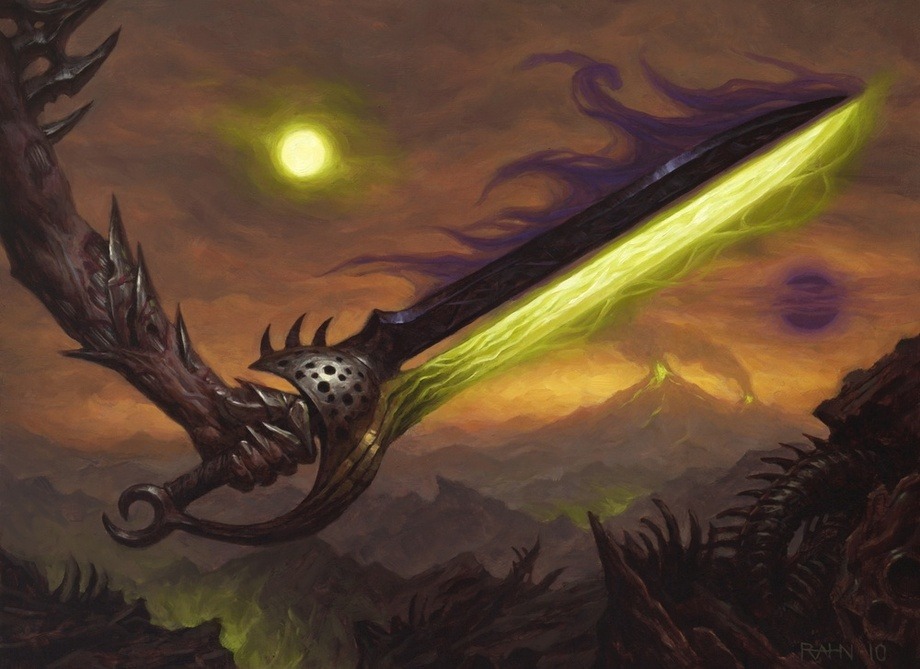
Sword of Feast and Famine | Illustration by Chris Rahn
Equipment are a staple of Magic: the Gathering gameplay. Since Mirrodin, we haven’t seen a single premier set without equipment, and I doubt we ever will again. The subtype has become as ubiquitous as auras, and fills a similar yet slightly different slot in terms of gameplay. With WotC continuing to push equipment into new design space, I’m certain we’ll have loads more equipment to rank in the coming years.
What do you think? Are the “Swords of X and Y” really so spread out in terms of power level? Should Umezawa's Jitte be unbanned in Modern? And what are some of your favorite low-power equipment? Let me know in the comments, or over on Draftsim’s Twitter/X.
Thanks for reading, and be prepared!
Follow Draftsim for awesome articles and set updates: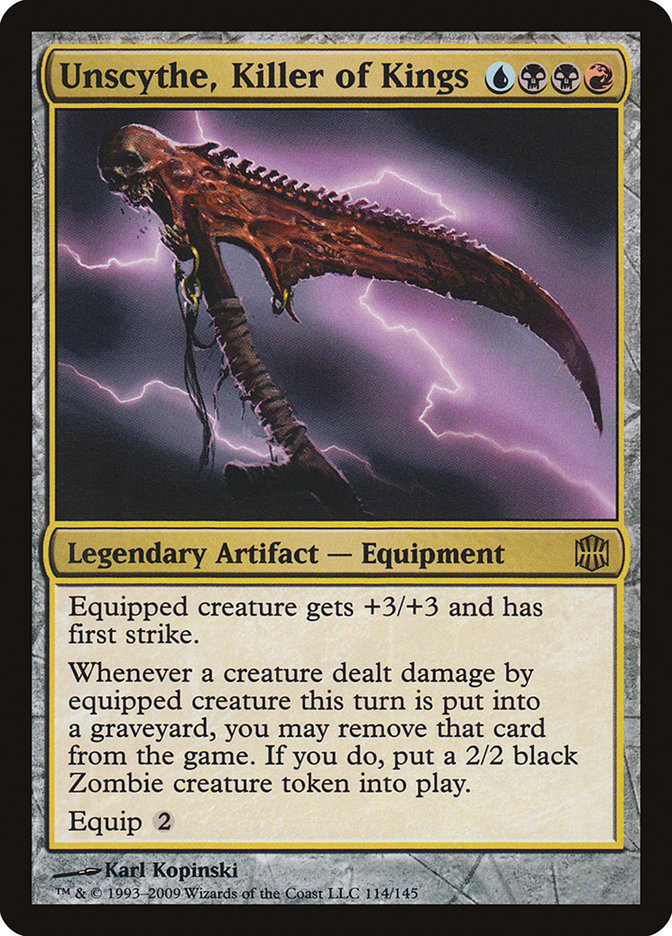

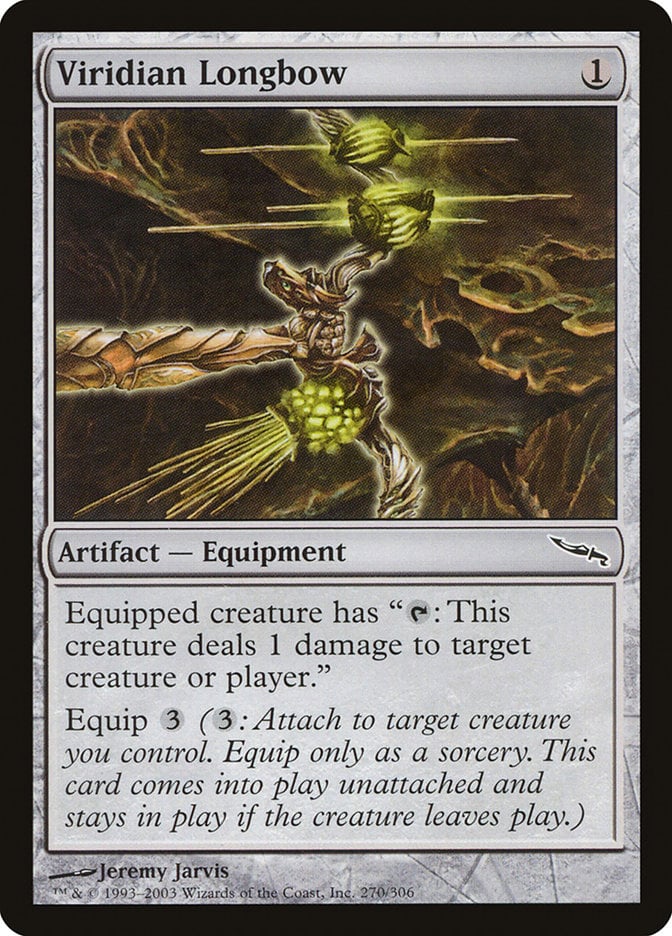
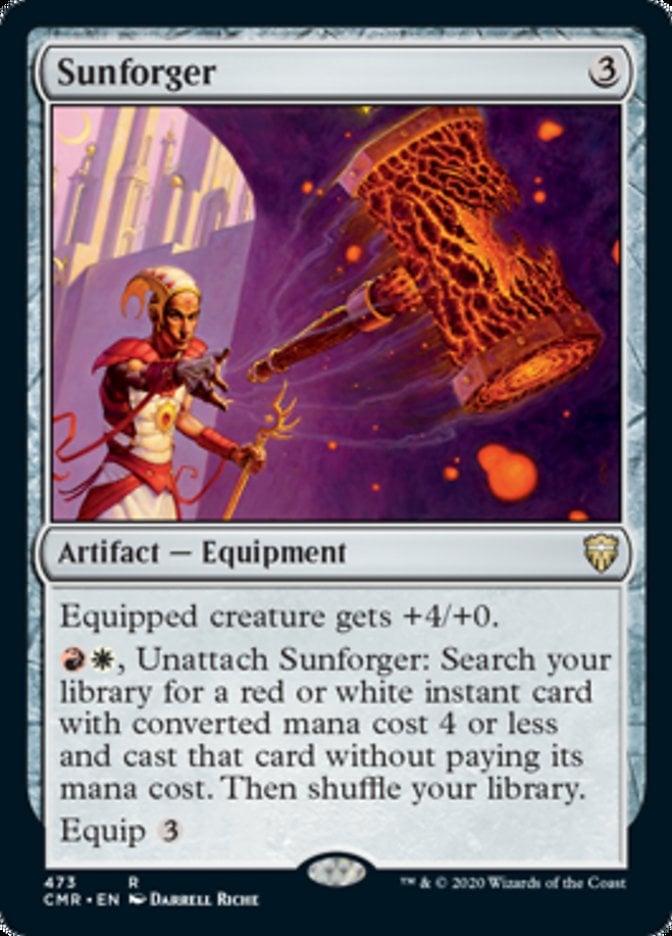
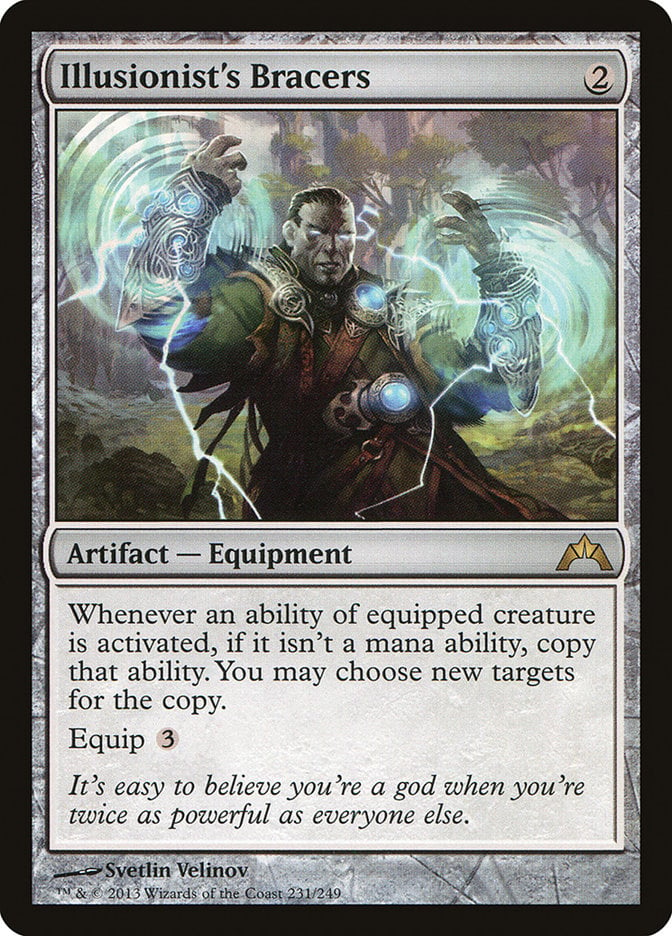
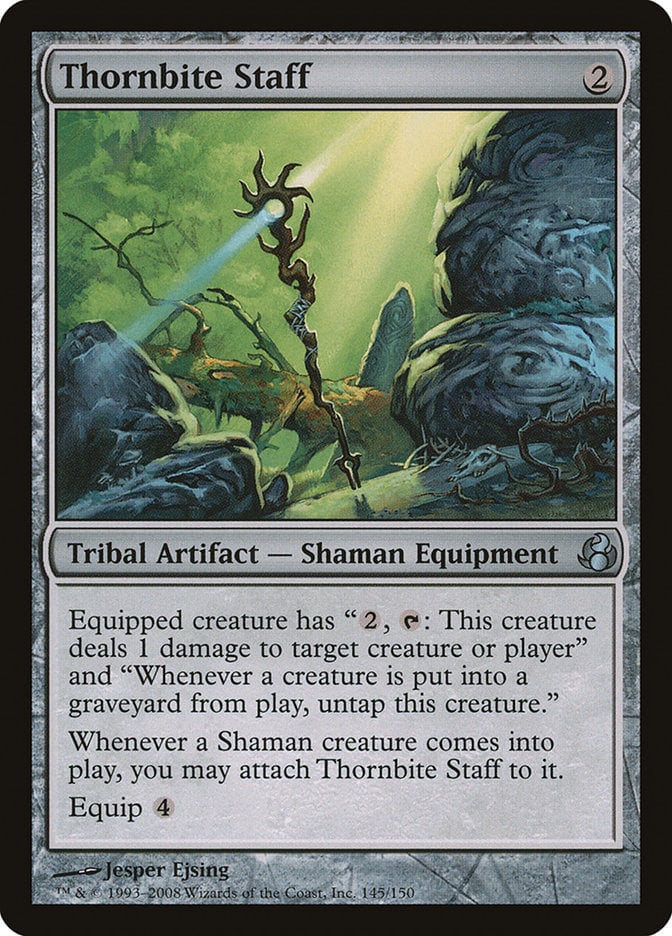
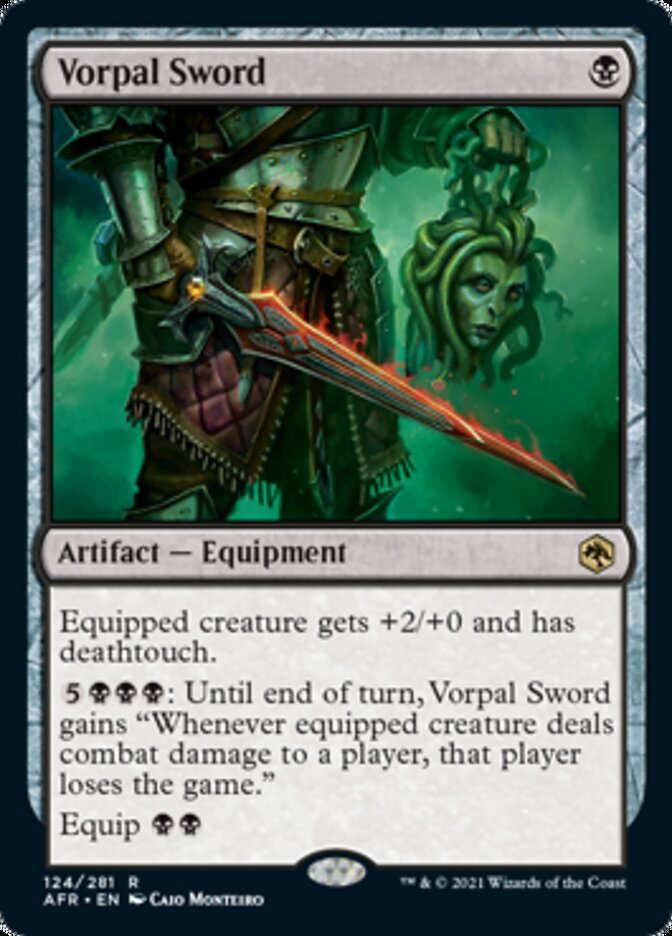
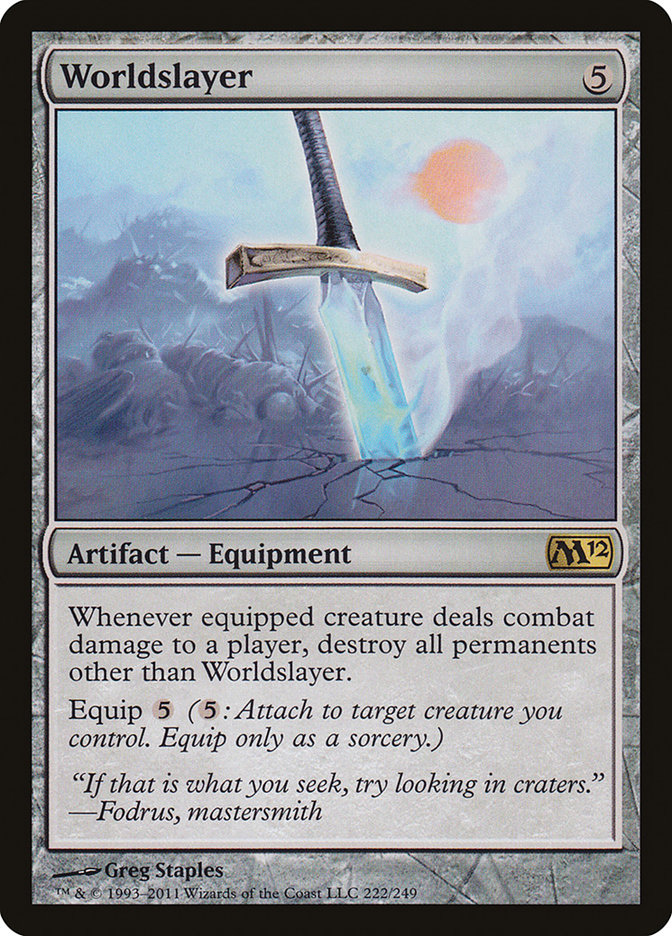


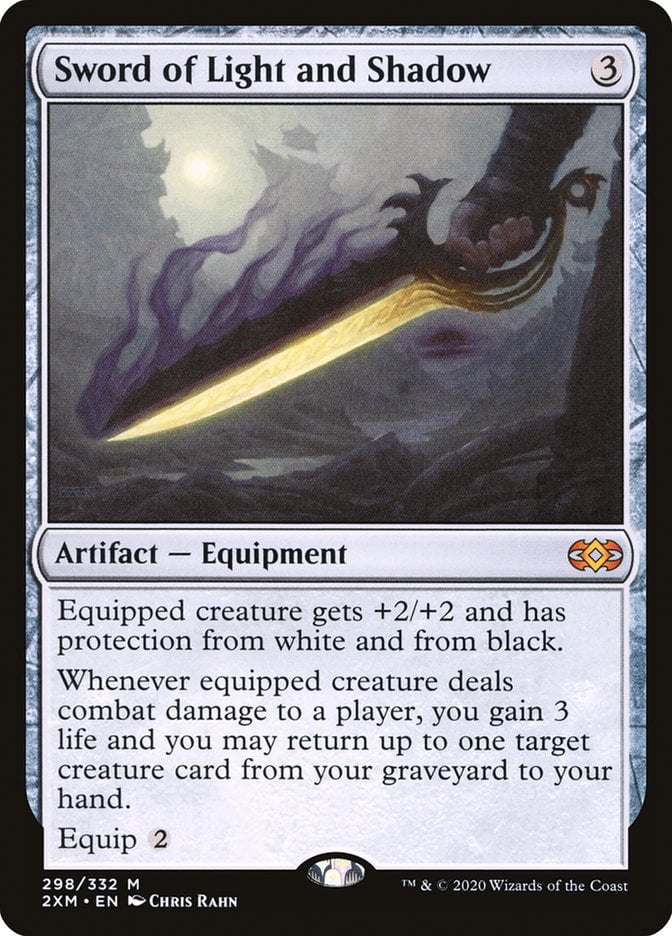
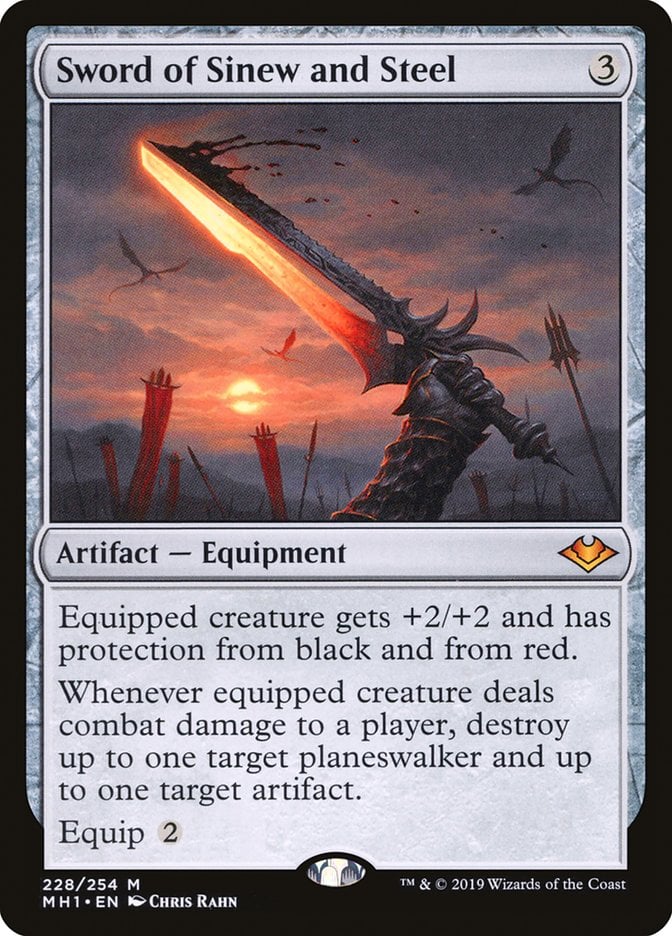
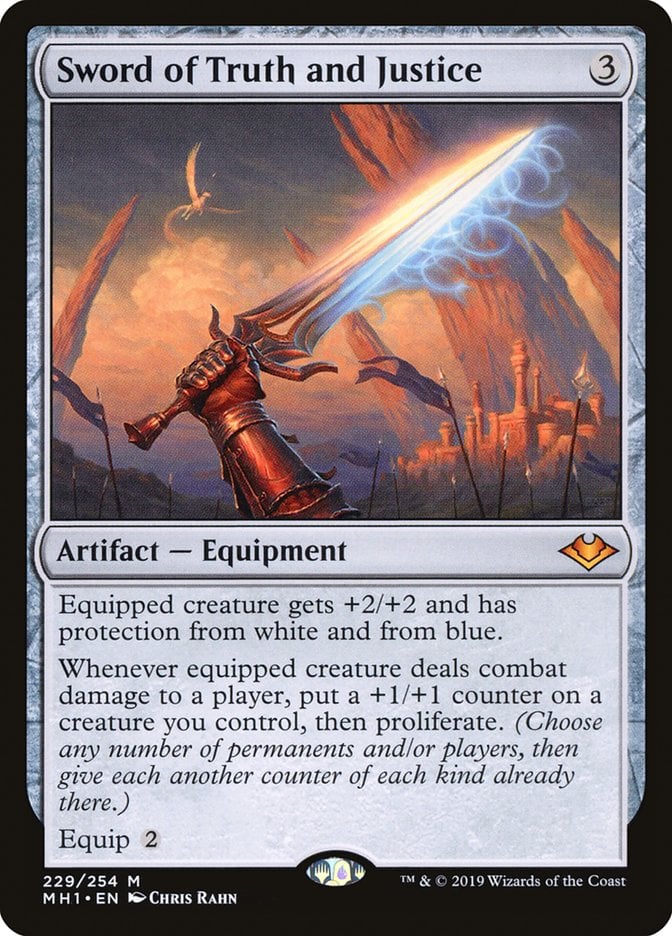
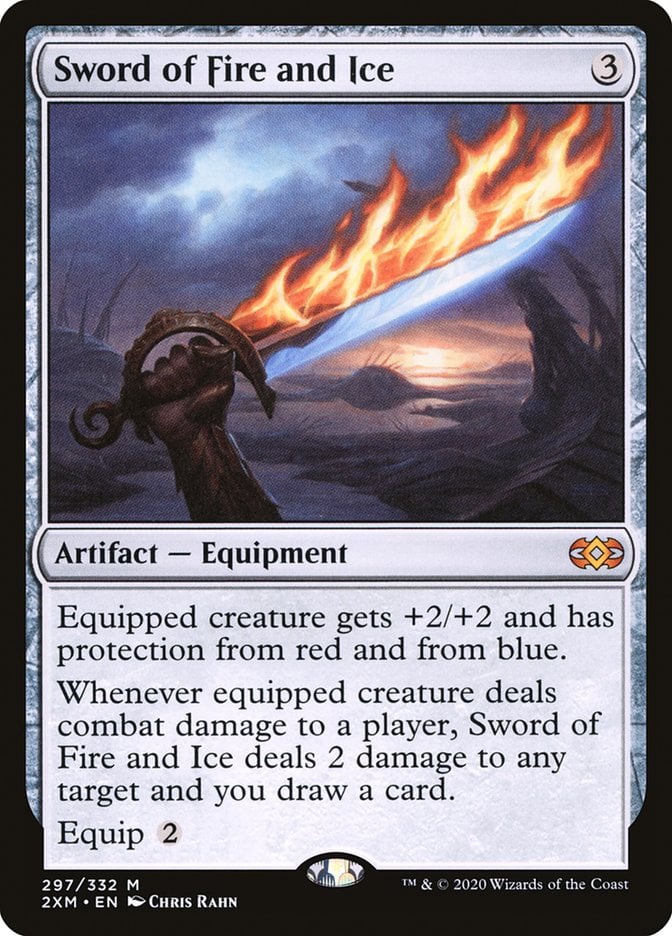
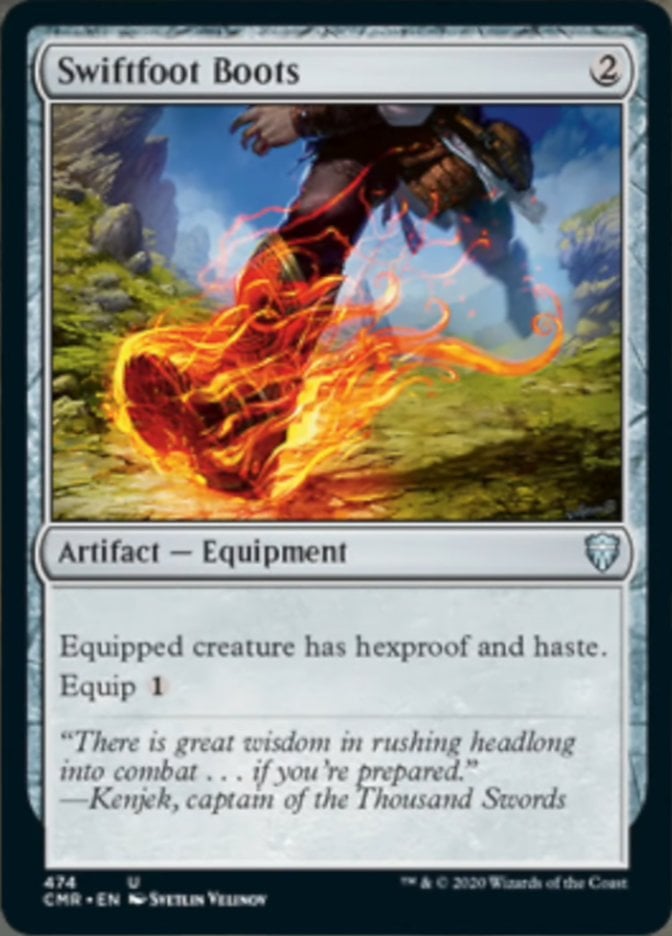

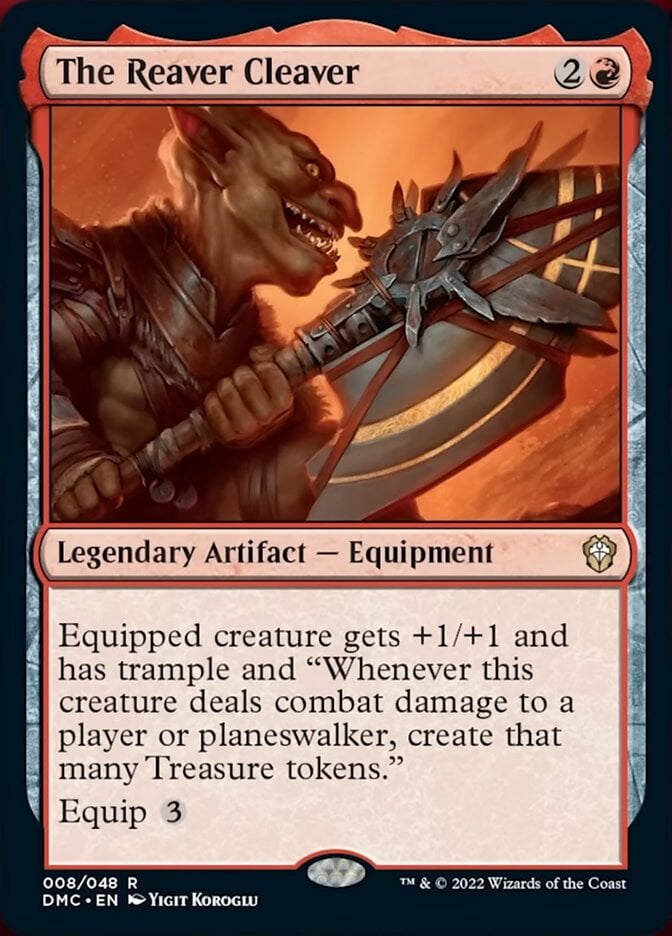
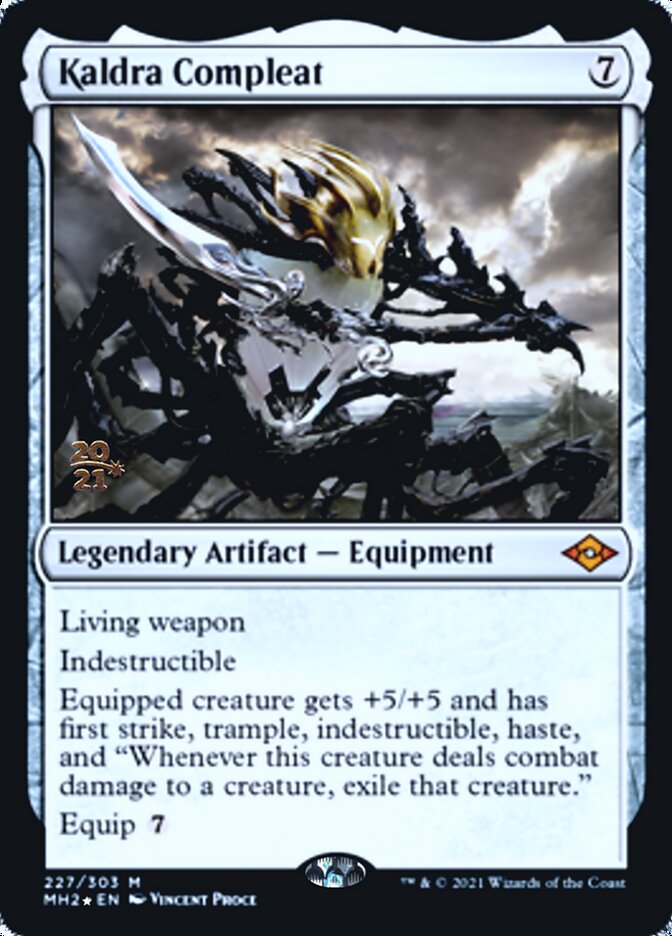
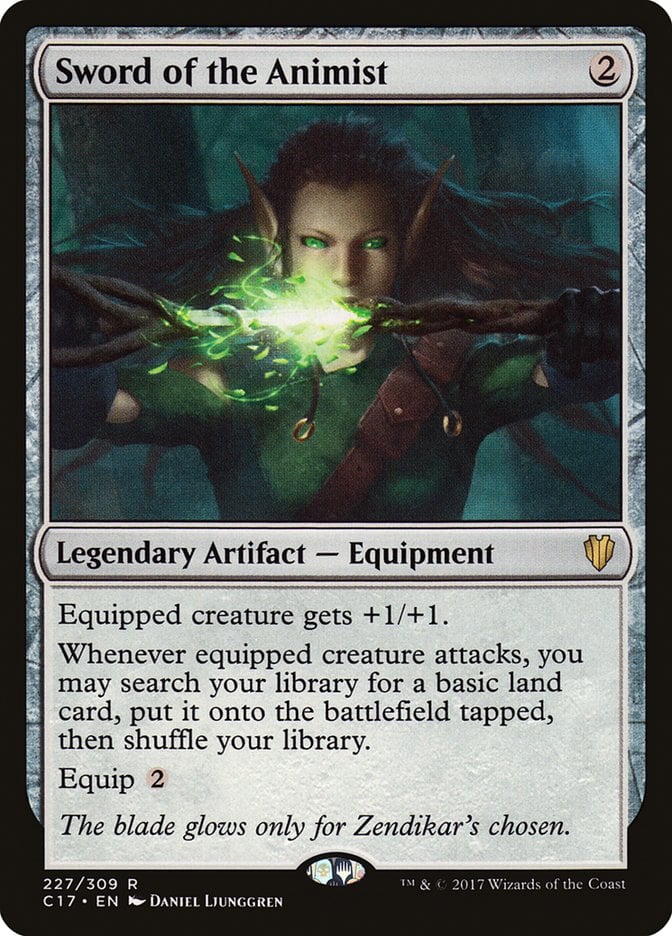
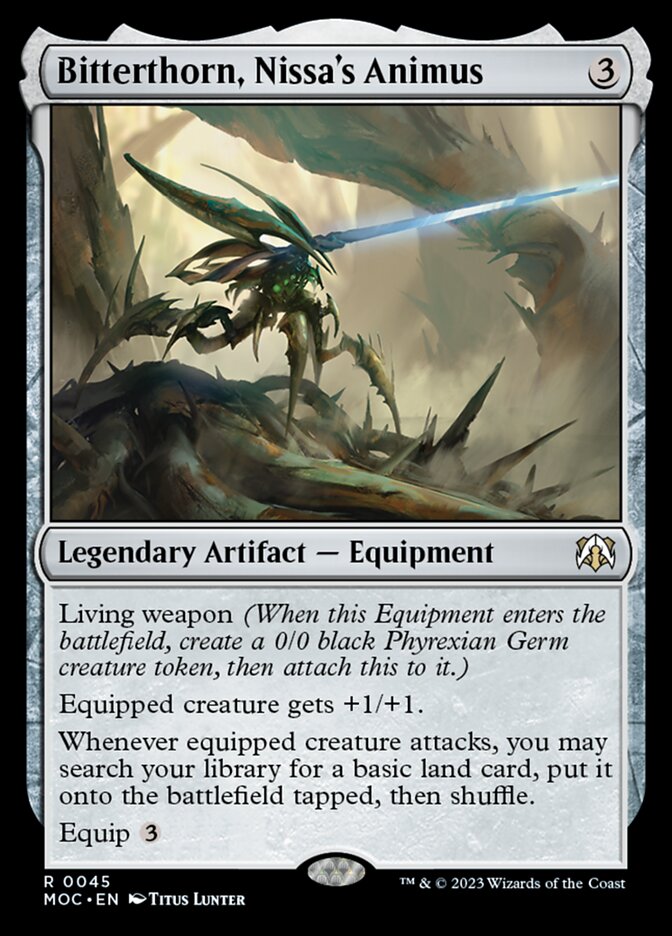
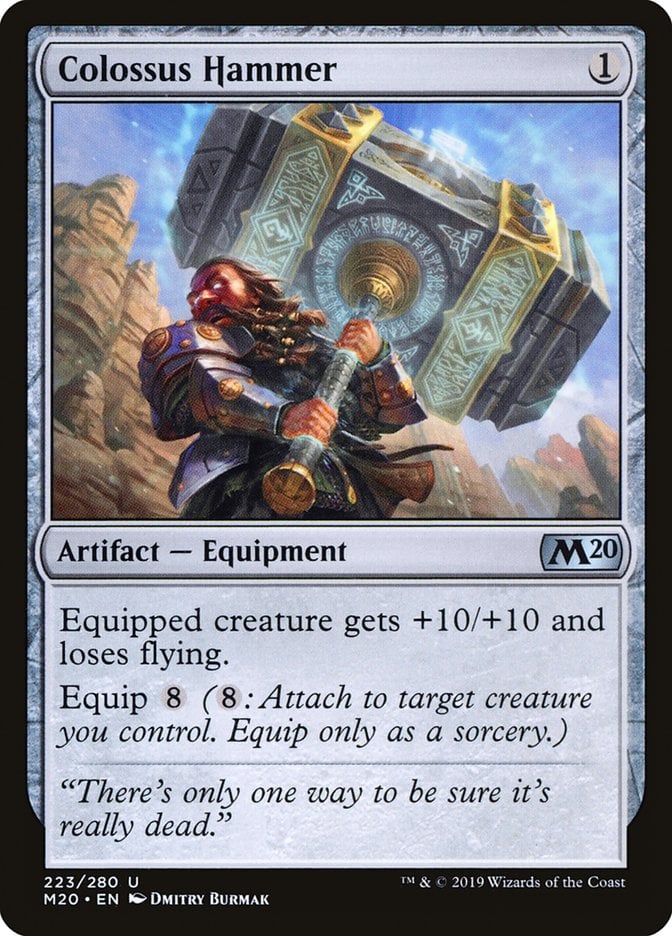



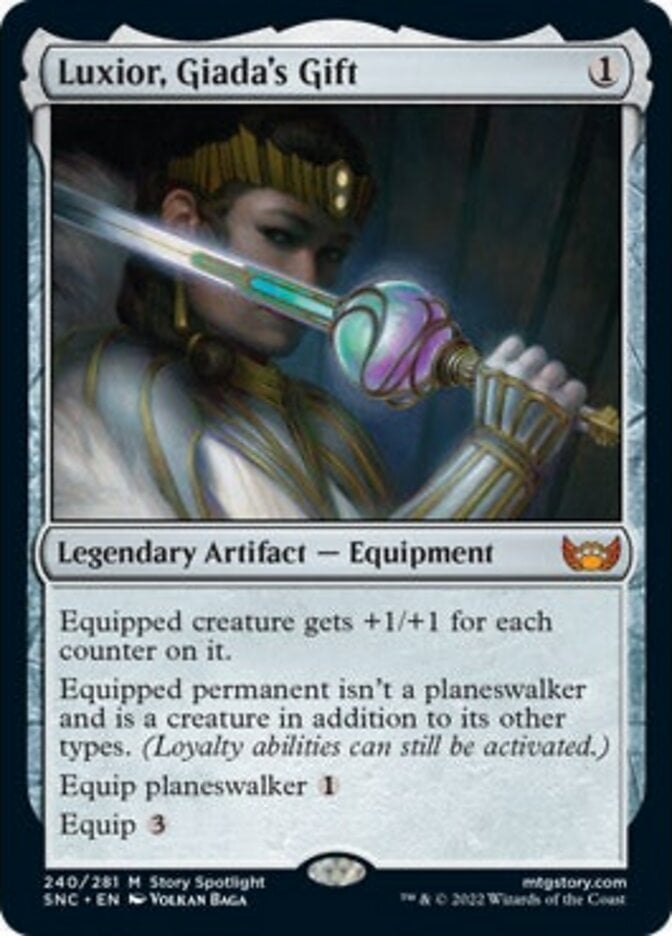
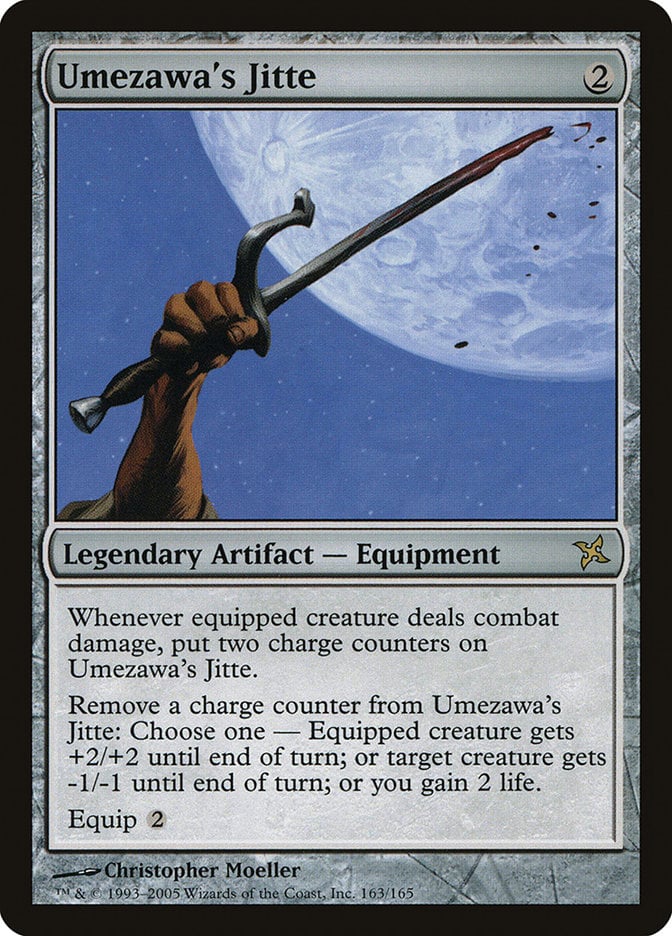
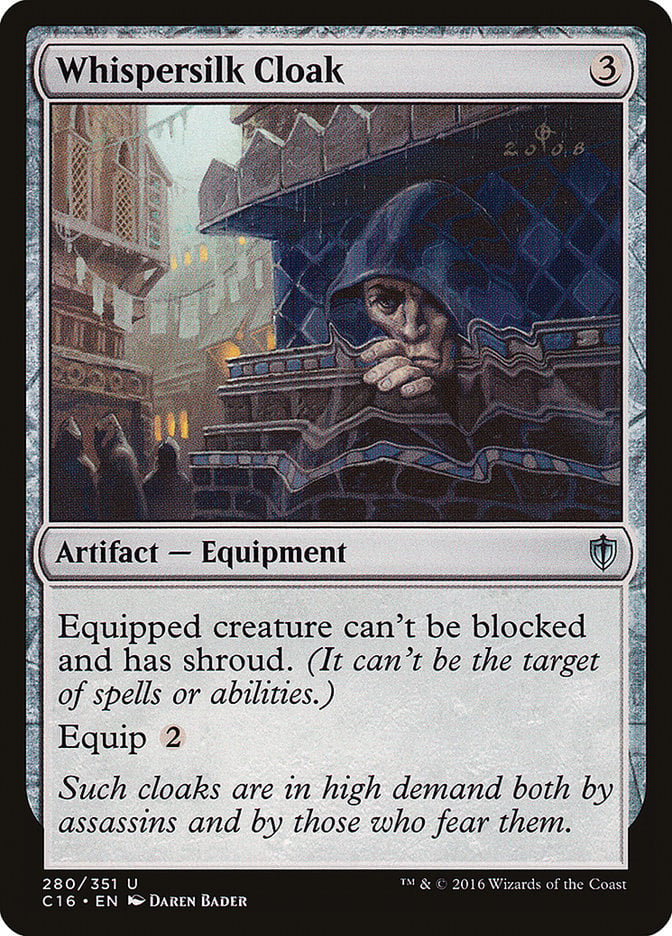
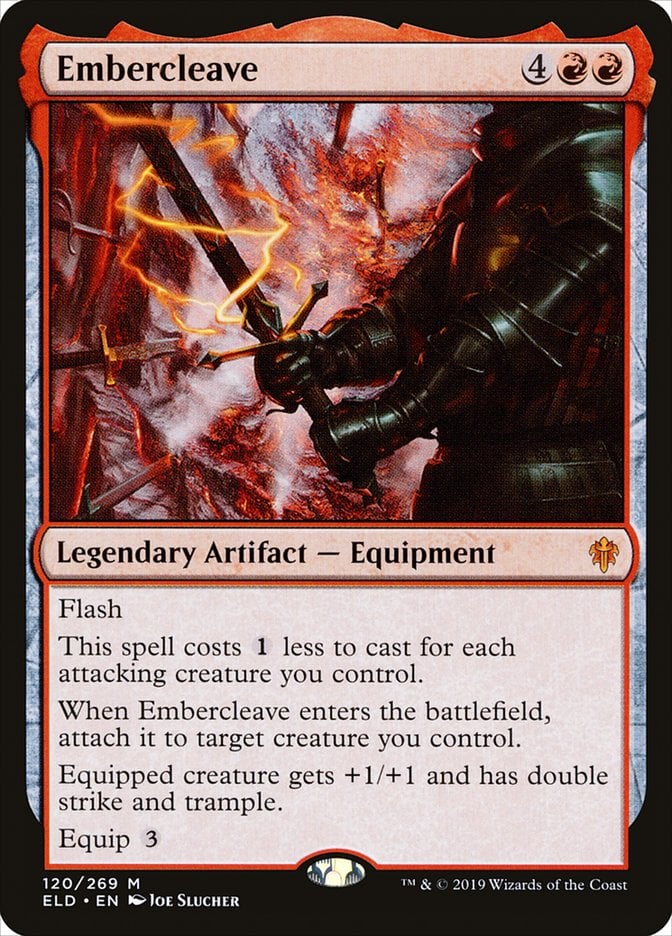

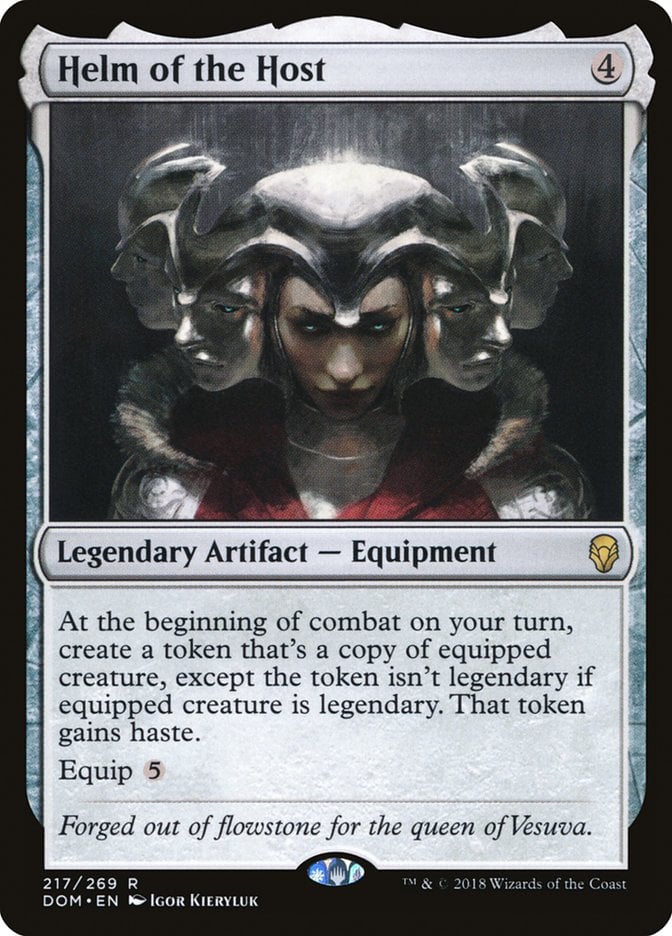
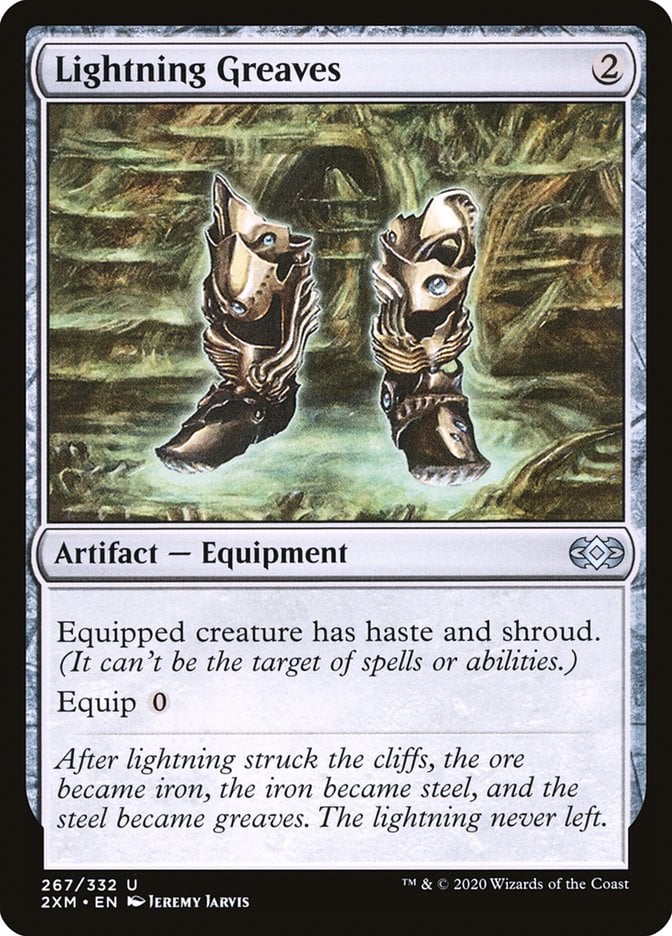
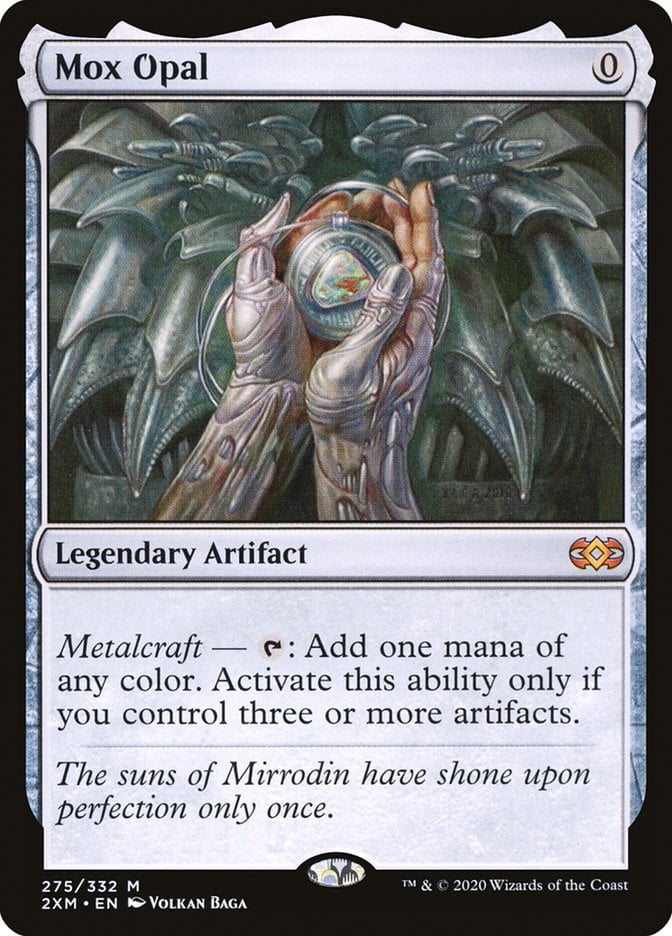
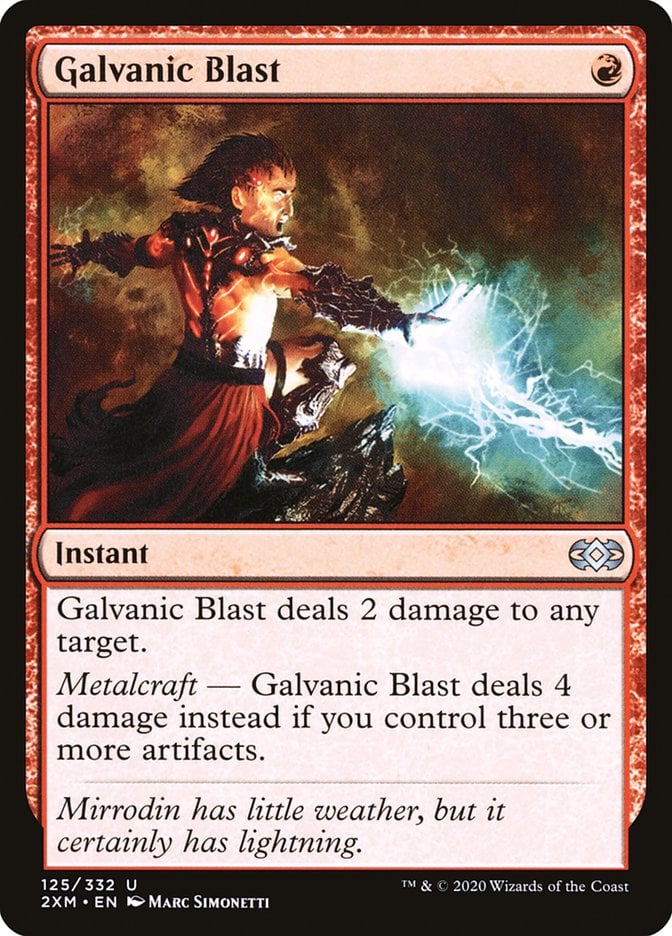

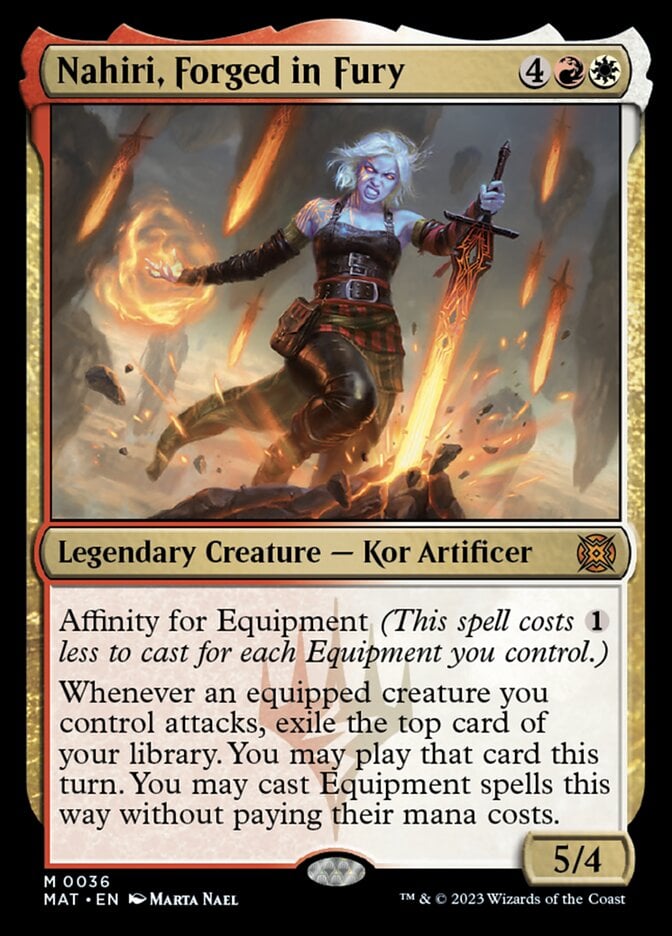

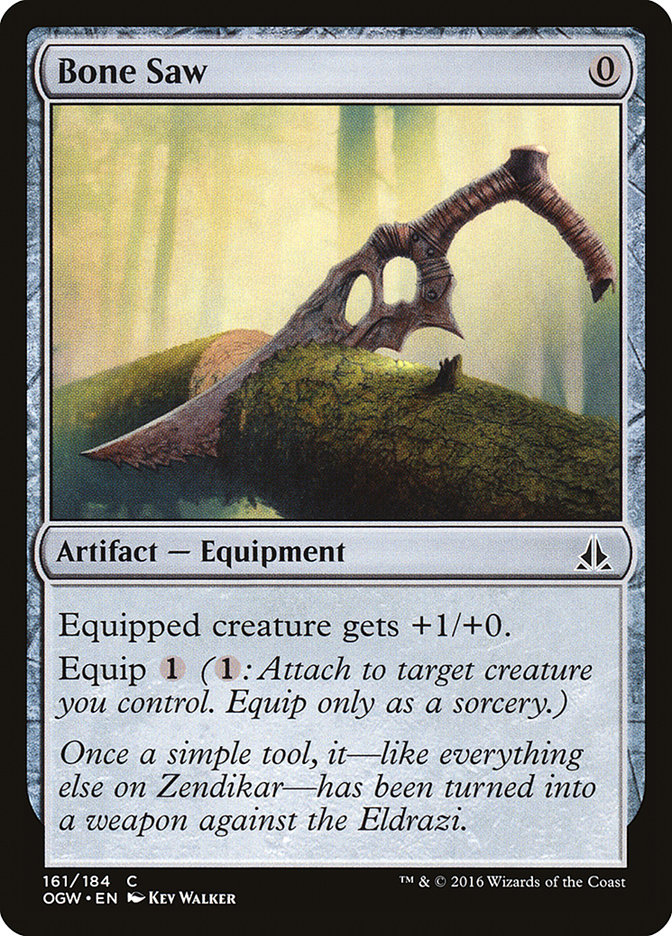
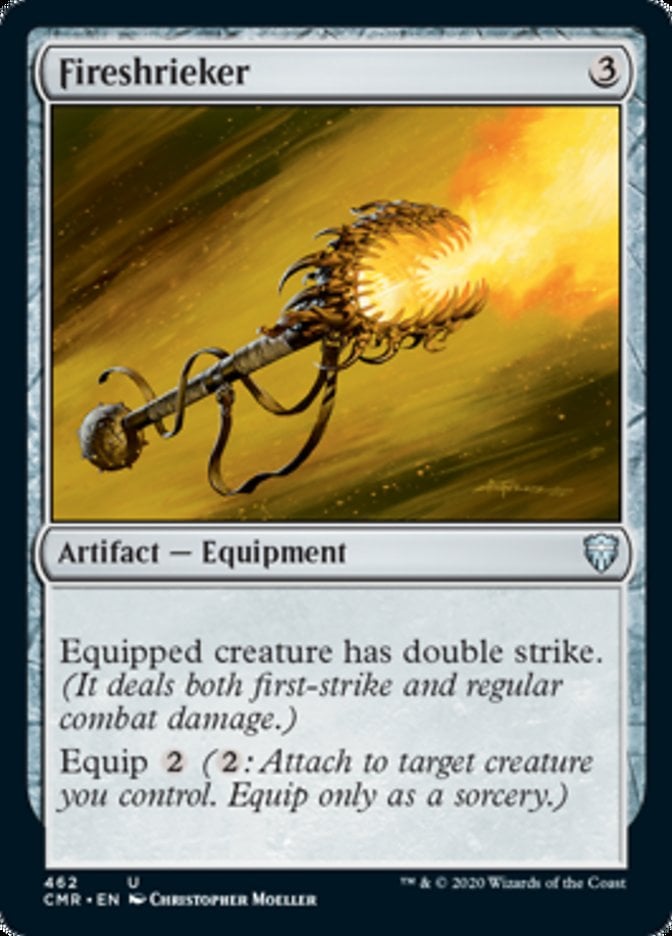

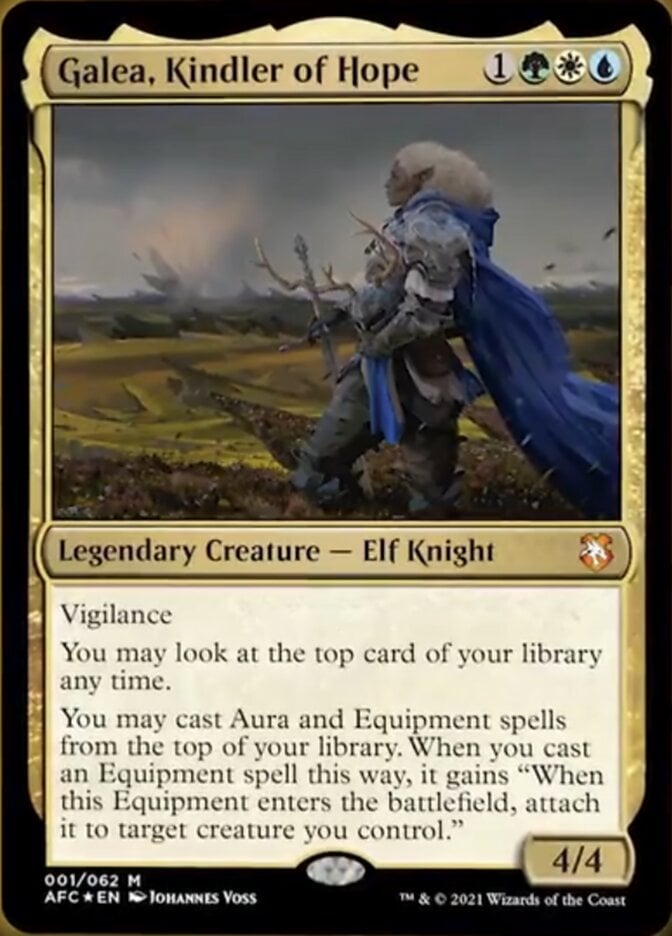
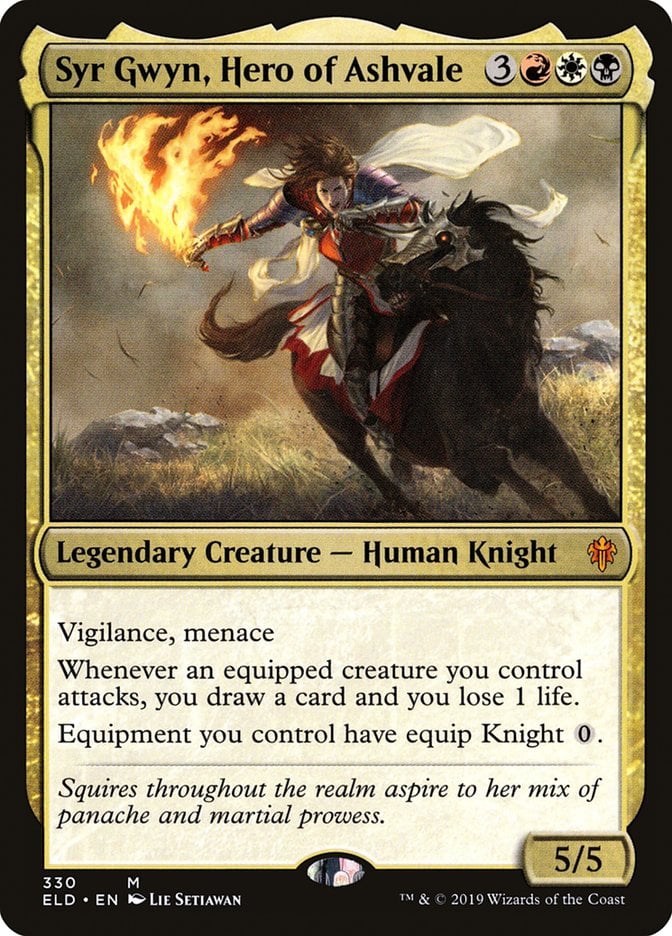
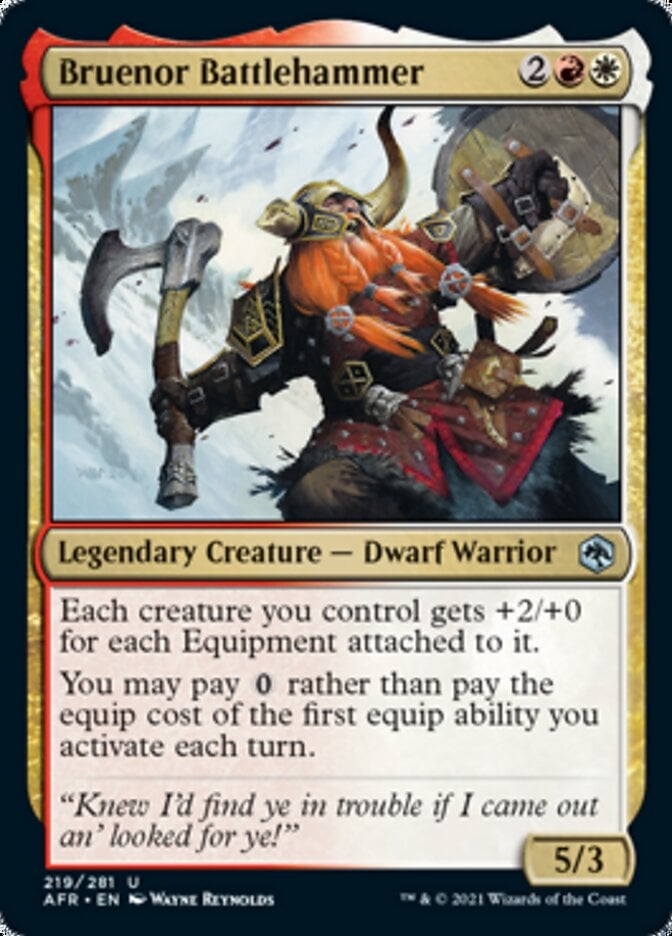
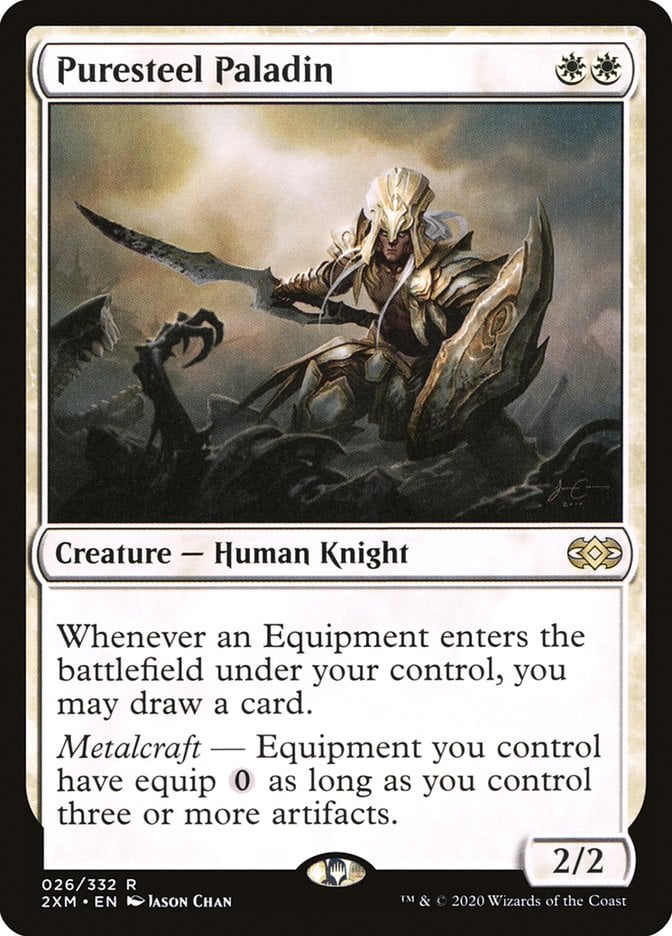
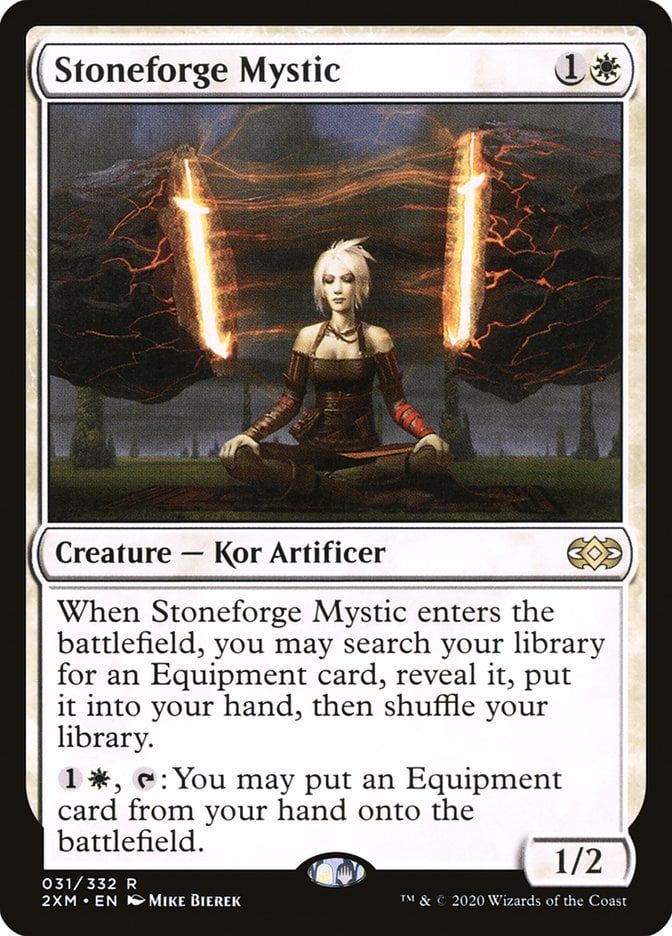
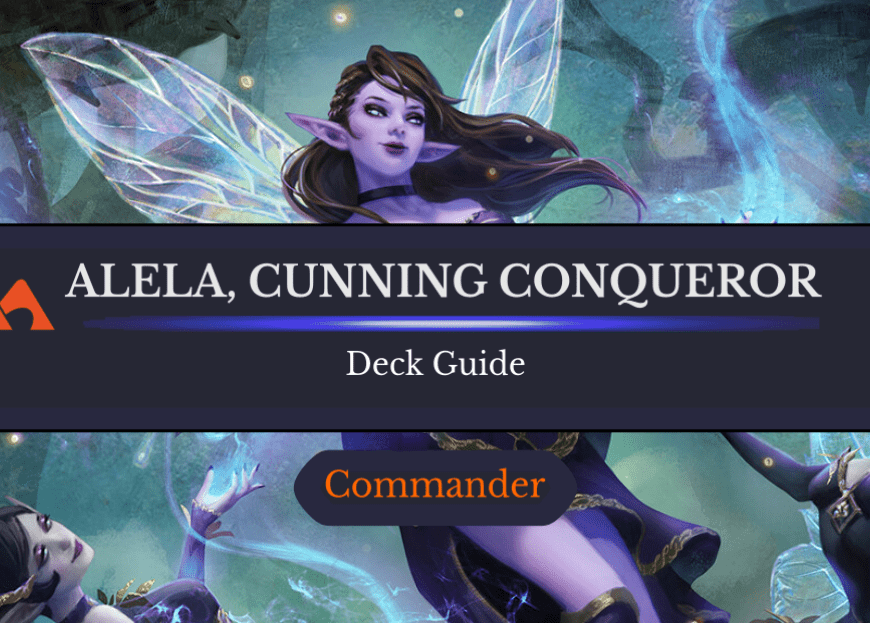
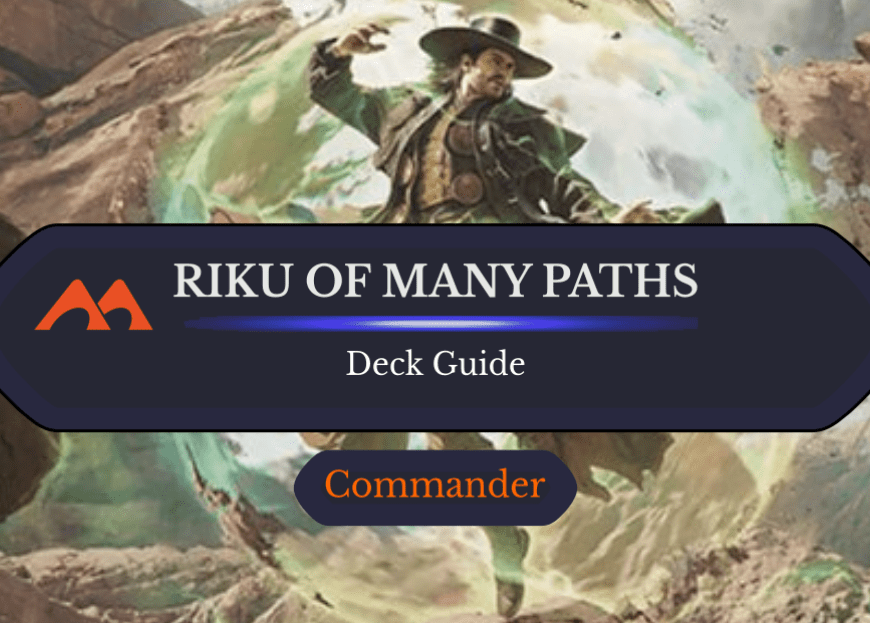
2 Comments
Bitterthorn is 3 mana, and sword of the animist is 2 mana, but your list says bitterthorn is one mana cheaper. What am I missing?
Hi Zach – I’m counting up the total mana you have to invest before you’ll see any returns on the equipment. While Bitterthorn is 1 more CMC than Sword of the Animist, the living weapon means it’ll skip that first equip cost. Because of this, Bitterthorn is a three mana investment before you’ll see any damage, and Sword of the Animist a four mana one.
Add Comment